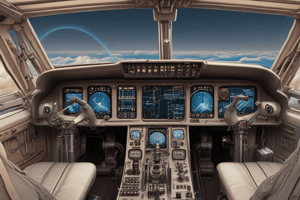Podcast
Questions and Answers
What is the primary function of a feedback mechanism in a control system?
What is the primary function of a feedback mechanism in a control system?
- To monitor the system's output and compare it to the desired output (correct)
- To adjust the system's input based on the measured output
- To generate a random output signal
- To amplify the error signal
What type of feedback reduces the error between the actual and desired output?
What type of feedback reduces the error between the actual and desired output?
- Negative Feedback (correct)
- Oscillating Feedback
- Positive Feedback
- Random Feedback
Which component of a feedback loop compares the measured output to the desired output?
Which component of a feedback loop compares the measured output to the desired output?
- Sensor
- Actuator
- Comparator (correct)
- Error Signal
What is the primary purpose of the state equation in state-space control?
What is the primary purpose of the state equation in state-space control?
Which of the following is a key concept in state-space control related to the ability to determine the system's state from the output signal?
Which of the following is a key concept in state-space control related to the ability to determine the system's state from the output signal?
What is the purpose of controller tuning in a control system?
What is the purpose of controller tuning in a control system?
What is the Ziegler-Nichols method used for in controller tuning?
What is the Ziegler-Nichols method used for in controller tuning?
What determines the rate of change of the error signal's derivative in a control system?
What determines the rate of change of the error signal's derivative in a control system?
What is the term for the ability to drive the system to a desired state using an input signal in state-space control?
What is the term for the ability to drive the system to a desired state using an input signal in state-space control?
What is the primary goal of pole placement in state-space control?
What is the primary goal of pole placement in state-space control?
Which of the following state-space control techniques is used to optimize a performance index?
Which of the following state-space control techniques is used to optimize a performance index?
Flashcards are hidden until you start studying
Study Notes
Feedback Mechanisms
- Definition: A feedback mechanism is a control system component that monitors the system's output and compares it to the desired output, generating an error signal that drives the system towards the desired state.
- Types of Feedback:
- Negative Feedback: Reduces the error between the actual and desired output, stabilizing the system.
- Positive Feedback: Amplifies the error, often leading to instability.
- Feedback Loop Components:
- Sensor: Measures the system's output.
- Comparator: Compares the measured output to the desired output.
- Error Signal: The difference between the measured and desired output.
- Actuator: Adjusts the system's input based on the error signal.
Controller Tuning
- Definition: Controller tuning involves adjusting the control system's parameters to achieve optimal performance, stability, and response.
- Tuning Methods:
- Trial and Error: Iterative process of adjusting parameters based on system response.
- Ziegler-Nichols Method: A heuristic approach for tuning PID controllers.
- Frequency Response Analysis: Analyzing the system's frequency response to determine optimal gains.
- Controller Tuning Parameters:
- Gain: Amplifies the error signal.
- Integral Time: Determines the rate of change of the error signal.
- Derivative Time: Determines the rate of change of the error signal's derivative.
State-Space Control
- Definition: State-space control is a mathematical approach to control systems, representing the system's dynamics using state variables and linear algebra.
- State-Space Equations:
- State Equation: Describes the evolution of the system's state variables over time.
- Output Equation: Relates the system's output to the state variables.
- State-Space Control Systems:
- Controllability: The ability to drive the system to a desired state using an input signal.
- Observability: The ability to determine the system's state from the output signal.
- State-Space Control Techniques:
- Pole Placement: Placing the system's poles to achieve desired stability and response.
- Linear Quadratic Regulator (LQR): Optimal control technique for minimizing a performance index.
Studying That Suits You
Use AI to generate personalized quizzes and flashcards to suit your learning preferences.




